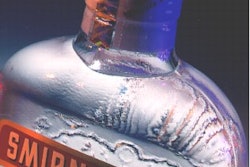“I loved the concept right away, and I saw great potential for it in the U.S.” That’s how president Ronnie Wrenn of Fresher Than Fresh Inc. describes his first impression of a new cook-in package concept called “Dream Steam.” Developed by Creative New Food (Eglisau, Switzerland) with help from Wipf AG (Volketswil, Switzerland), Dream Steam was first commercialized in Switzerland by the Migros supermarket chain.
It’s a three-component plastic package with a one-way “cooking valve” that makes it possible to package and ship fresh vegetables and fresh meat, fish, or poultry along with a precooked starch like pasta or rice—all in one cook-in container. Backflushed with a mix of carbon dioxide, nitrogen, and oxygen, the package offers FTF an eight-day refrigerated shelf life. Dream Steam received the President’s Award in the WorldStar 2000 packaging competition sponsored by the World Packaging Organisation (see May ’01, p. 2, or packworld.com/go/migros).
When Wrenn first saw Dream Steam nearly three years ago at a European seafood fair in Brussels, he already knew a thing or two about packaging case-ready fresh fish. At the time, his Gastonia, NC, company had a full year’s experience with modified-atmosphere packaging of fresh fish that delivered a 10-day refrigerated shelf life (see sidebar on p. 38). But that product line was not in a cook-in tray, nor did it include fresh vegetables and a starch. So Wrenn decided to complement his fresh fish offerings by adding a complete gourmet fish meal in a cook-in Dream Steam pack.
This new product line is called Gourmet To Go. Initiated in February, it’s now in four Harris Teeter supermarkets, all within 20 miles of FTF’s Gastonia facility. Each of three salmon varieties, with net weights from 8.66 to 13.3 oz, retails for about $6. A shrimp item sells for $7.
FTF fills the polypropylene Dream Steam trays by hand and then sends them through a two-up sealing system from Ross Industries (Midland, VA). It evacuates the trays and backflushes them with a mix of carbon dioxide, nitrogen, and oxygen. Then it heat-seals clear lidding material to the tray flanges.
A paperboard sleeve with attractive graphics and all necessary product information and company identification is applied by hand. Supplied by Subtle Impressions (Charlotte, NC), the sleeve is a 10-pt SBS printed flexo in eight colors. A die-cut hole exposes the one-way valve, and copy surrounding the valve says: “First time in America, Revolutionary cooking valve.”
Wrenn is clearly intrigued by Dream Steam’s potential. “In our first week in just two stores we sold 1귔 units,” says Wrenn. “We’re committed to it and have put a lot of money behind it.”
How it works
So what is Dream Steam, and how does the package actually work? Basically it’s a new twist on the good old-fashioned pressure cooker, an airtight vessel for cooking food by means of superheated steam under pressure. How it differs from a conventional pressure cooker is best described by Dream Steam inventor Carlo Keller, general manager of the food engineering R&D firm known as Creative New Food. He believes Dream Steam is nothing less than revolutionary.
“Conventional cooking brings heat outside to inside,” says Keller. “With this package, we heat from the inside first, relying on microwave energy. Water content inside the food is transformed to steam as the microwaves heat it. As the steam exits the food tissue, it does so under pressure, which means the food is cooked from the inside out by both heat and pressure. Gradually, the steam inside the package builds pressure, which means the food also gets cooked by heat and pressure from the outside in. This ‘double-pressure situation’ is unique. It’s completely new.” A patent has been applied for, says Keller.
A number of benefits accrue. First, because steam is formed without having to add extra water, Dream Steam cooking causes minimal loss in food weight or mass, says Keller. Organoleptic qualities are optimized and nutrition content maximized, he adds.
Second, the double-pressure cooking technology means that cooked food can remain in the microwave oven long after it’s done with no drop-off in texture, quality, taste, or nutrition content.
“Take zucchini, for example,” says Keller. “In the microwave oven it might cook in 30 seconds. A carrot, on the other hand, takes three minutes. In our system, thanks to the double-pressure situation, the zucchini will essentially stop cooking once it’s done, almost as if it’s been put to sleep.”
David Tatman, corporate chef at FTF, puts it this way: “The food somehow reaches a plateau and basically stops cooking.” Had he ever encountered such a thing before? “Never. I was in awe when it was first demonstrated and explained to me.”
Watching it work
Watching the package in action in the microwave is fascinating, to say the least. As internal pressure builds, the package blows up like a balloon, expanding by at least 50% from its original dimensions. Here is where the one-way valve in the lidstock comes in. By releasing internal pressure at a carefully controlled rate, it prevents the package from bursting yet maintains sufficient pressure inside the package to ensure that pressure cooking takes place.
The design of the valve is one of the key contributions made by Wipf, a converter of flexible films and producer of one-way valves commonly used on bags of coffee that need to degas.
“We tried five or so different valve technologies that are available out there, but the only one we liked was Wipf’s,” says Keller. “Still, we needed to modify it so that it would open and close precisely in response to very low internal pressure created by the respiring vegetables that go into our package.”
Wipf has applied for a patent on the Wicovalve® used on Dream Steam packages. Essentially, it consists of an injection-molded polyethylene piece with five small holes punched into it. Covering this piece and the holes is a thin film (which can be made from several different resins) that clings tightly because there’s a tiny drop of food-grade oil between the PP and the film. Like two pieces of glass with a thin layer of water between them, the PP and the film cling to each other owing to capillary attraction. This produces an air-tight seal.
However, when the respiring vegetables inside the package give off gas, or when steam builds up inside the package during microwaving, internal pressure is created, enough pressure to lift the film covering the PP valve. This permits internal pressure to be relieved by way of the holes in the PP (a corresponding hole is punched into the lidding material and the Wipf valve is heat-sealed over this hole). As soon as internal pressure drops, capillary attraction causes the two layers of the valve to cling again, restoring the air-tight seal.
Packaging specs make the difference
Equally critical in making Dream Steam work are the performance characteristics of the polypropylene tray and clear film lidding material. Both these components must be able to expand to nearly twice their size during microwave cooking and then return back to their original shape.
The tray is thermoformed, says Keller, from sheet that’s extruded “from several PP compounds specified by Creative New Food.” In Europe there are three tray suppliers fully capable of meeting Dream Steam specs. FTF imports its PP trays from Faerch Plastics (Holsterbro, Denmark).
Lidding, a two-layer lamination of polyester on top and PP on the tray-contact side, is supplied by Wipf. For now, each lid is supplied as an individual rectangular sheet with the Wicovalve heat-sealed in place. A sheet is clipped onto a tray just before the tray is slid into the Ross evacuation/backflushing/sealing station; excess film around the oval-shaped tray is trimmed in the same station. But soon to be installed at FTF is a new tray-sealing system from Sealpac Intl. (Oldenburg, Germany). It will heat-seal the valves to roll-fed lidstock just ahead of the sealing station.
Also about to be launched by FTF is a fish-only Dream Steam package. It will have no rice, no pasta, no vegetables—just fish and possibly a marinade. It should be reaching store shelves as soon as a new label is designed. “They haven’t gone the fish-only route in the European market, but we want very much to try it here,” says Wrenn.
Poultry is in the works, too, which would be a departure for a firm that has never ventured beyond the world of seafood marketing. Wrenn doesn’t see it as that big a leap.
“When I think about applications of the Dream Steam technology, I don’t think in terms of being in the fish business, or the vegetable business, or the poultry business,” says Wrenn. “I’m talking about being in the packaging business, about gathering up all these food combinations that will work with this technology and packaging them. That’s different from being a fish or poultry trader.”
Poultry, of course, will bring U.S. Dept. of Agriculture inspection into the picture. But Tatman doesn’t see that as any particular problem. The Gastonia plant is already scrutinized by the Food & Drug Administration, an agency that worries greatly about MAP fresh fish because if oxygen is not sufficiently present in a package of fish and/or temperature abuse occurs, clostridium botulinum is a deadly possibility.
“We have the most intense HACCP plan you could imagine,” says Tatman. He adds that the company’s relationship with FDA has been a mutually beneficial one. “Rather than establish a confrontational relationship, it makes sense for the FDA to work with firms like ours to set sanitation and temperature guidelines and then work with us to ensure the guidelines are adhered to.”
Cost tradeoffs
Wrenn admits that the packaging materials behind Dream Steam are not cheap, but he’s quick to point out that they’re not prohibitively expensive. “The addition of the valve makes the lidding a little more pricey, but it’s not that bad,” Wrenn says. “And the tray is about the same as the barrier foam tray we’ve been using for fish the last four years.”
Distribution is also more costly with a package whose shelf life is only eight days. “So far Gourmet To Go has been handled on a store-door basis,” says Wrenn. “It goes out on our trucks and our people go in-store to make sure the product is properly rotated. Originally we viewed that as a drawback. But the more we think about it, maybe that’s the way this kind of item should be handled.” Also being explored are time/temperature indicators.
Offsetting the upcharge that must be paid for materials and the added cost of store-door delivery are significant savings gained from reduced in-store labor costs and the near elimination of shrink.
“Shrink on our case-ready fish is 1%,” says Wrenn. “At the service counter it’s 9%.”
Ultimately, of course, it’s the consumer who will decide whether Dream Steam succeeds or fails. Its inventor would have it no other way.
“The whole idea behind this kind of intelligent package is that it combines food engineering and packaging engineering to bring terrific functionality to the consumer,” says Keller.
If consumers don’t respond, all the WorldStar awards in the world won’t make much difference.
See sidebar to this article: Foam barrier tray, too



























